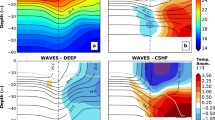Abstract
Serious gaps in knowledge about ocean spray at wind speeds over 40m/s remain difficult to fill by observation or experiment; yet refined study of the thermodynamics of Tropical Cyclones (including typhoons and hurricanes) requires assessment of the hypothesis that 'spray cooling' at extreme wind speeds may act to reduce (i) the initial temperature of saturated air rising in the eyewall and so also (ii) the input of mechanical energy into the airflow as a whole. Such progressive reductions at higher speeds could, for example, make any possible influence of future global warming on Tropical Cyclone intensification largely self-limiting. In order to help in extrapolation of knowledge on ocean spray to extreme wind speeds, a probabilistic analysis is introduced which allows for the effects of gusts, gravity and evaporation on droplet distributions, yet in other respects is as simple as possible. Preliminary indications from this simplified analysis appear to confirm the potential importance of spray cooling.
Similar content being viewed by others
References
E. L. Andreas, J. B. Edson, E. C. Monahan, M. P. Rouault and S. D. Smith, The spray contribution to net evaporation from the sea: a review of recent progress. Boundary Layer Meteorol. 72 (1995) 3–52.
J. De Cosmo, K. B. Katsaros, S. D. Smith, R. J. Anderson, W. Oost, K. Bumke and H. Chadwick, Air-sea exchange of water vapor and sensible heat: the HEXOS results. J. Geophys. Res. 101 (1996) 12001–12016.
V. D. Pudov, The ocean response to the cyclones' influence and its possible role in their tracks. In: J. Lighthill, Zheng Zhemin, G. Holland and K. Emanuel (eds.) Tropical Cyclone Disasters. Beijing: Peking University Press (1993) pp. 367–376.
C. W. Fairall, J. D. Kepert and G. J. Holland, The effect of sea spray on surface energy transports over the ocean. The Global Atmosphere and Ocean System 2 (1994) 121–142.
J. Lighthill, Fluid Mechanics of Tropical Cyclones. J. Theor. Comput. Fluid Dyn. 10 (1998) 3–21.
K. A. Emanuel, The theory of hurricanes. Ann. Rev. Fluid Mech. 23 (1991) 179–196.
J. Lighthill, G. J. Holland, W. M. Gray, C. Landsea, K. Emanuel, G. Craig, J. Evans, Y. Kurihara and C. P. Guard, Global climate change and tropical cyclones. Bull. Amer. Met. Soc. 75 (1994) 2147–2157.
A. Henderson-Sellers, H. Zhang, G. Berz, K. Emanuel, W. Gray, C. Landsea, G. Holland, J. Lighthill, S. L. Shieh, P. Webster and K. McGuffie, Tropical cyclones and global climate change: A post-IPCC assessment. Bull. Amer. Met. Soc. 79 (1998) 19–38.
S. A. Petrichenko and V. D. Pudov, O parametrizatsii teplo-i vlago-obmena mezhdu okeanom i atmosferoi v tropikakh v shtormovykh usloviyakh. Meteorologiya i Gidrologiya (1996, No. 6) 92–100.
P. G. Black, G. J. Holland and V. Pudov, Observations of sea-air temperature difference in tropical cyclones as a function of wind speed: importance of spray evaporation. In: J.D. Jasper and P.J. Meighen (eds.) Parametrisation of Physical Processes: Papers Presented at the Fifth BMRC Modelling Workshop, November 1993. BMRC Research Report No. 46, Melbourne: Bureau of Meteorology Research Centre (1994) p. 87.
M. P. Rouault, P. G. Mestayer and R. Schiestel, A model of evaporating spray droplet dispersion. J. Geophys. Res. 96 (1991) 7181–7200.
J. B. Edson and C. W. Fairall, Spray droplet modeling. I. Lagrangian model simulation of the turbulent transport of evaporating droplets. J. Geophys. Res. 99 (1994) 25295–25311.
G. de Leeuw, Profiling of aerosol concentrations, particle size distributions and relative humidity over the North Sea. Tellus 42B (1990) 342–354.
G. I. Taylor, Diffusion by continuous movements. Proc. Lond. Math. Soc. (2) 20 (1921) 196–212.
J. C. R. Hunt, Turbulent diffusion from sources in complex flows. Ann. Rev. Fluid Mech. 17 (1985) 447–485.
H. R. Pruppacher and J. D. Klett, Microphysics of Clouds and Precipitation, 2nd edition. Dordrecht: Kluwer (1997) 954pp.
Author information
Authors and Affiliations
Rights and permissions
About this article
Cite this article
Lighthill, J. Ocean Tpray and the Thermodynamics of Tropical Cyclones. Journal of Engineering Mathematics 35, 11–42 (1999). https://doi.org/10.1023/A:1004383430896
Issue Date:
DOI: https://doi.org/10.1023/A:1004383430896




